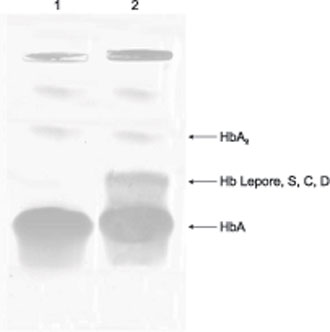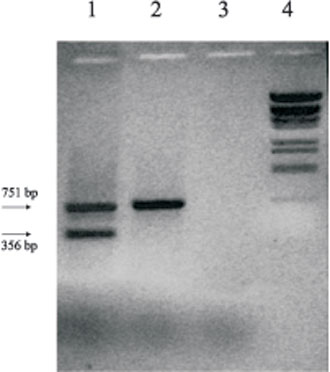


HOMOGENEITY OF THE Hb LEPORE GENE IN
FR YUGOSLAVIA
Urosevic J1, Djureinovic T1, Poznanic J1, Cvorkov-Drazic M2,
Bunjevacki G2, Janic D3, Krivokapic-Dokmanovic L3,
Popovic Z1, Pavlovic S1
*Corresponding Author: Dr. Sonja Pavlovic, Institute of Molecular Genetics and Genetic Engineering, Vojvode Stepe 444a, 11000 Belgrade, FR Yugoslavia; Tel: +381 11 3976 445; Fax: +381 11 3975 808; E-mail: sonya@sezampro.yu
page: 29
|
|
RESULTS
Screening analysis of Yugoslav patients with suspected thalassemia syndromes in last 4 years revealed six patients who were Hb Lepore carriers. Three were compound heterozygotes for Hb Lepore and b-thal, and they were affected with a thalassemia major syndrome. Family studies revealed 12 heterozygous relatives. All heterozygous carriers of Hb Lepore had a clinical phenotype of thalassemia trait. The hematological data for heterozygous Hb Lepore carriers (average values) are given in Table 1.
The Hb A2 value of all heterozygous carriers was normal or decreased (to 0.55%), while the Hb F value was slightly increased (1.6-2.4%). Hb analysis by electrophoresis on cellulose acetate of the 18 subjects (both patients and their relatives) revealed the presence of an abnormal Hb fraction. Its electrophoretic mobility pointed to four possible Hb variants: Hb Lepore, Hb D, Hb G and Hb S (Fig. 1). PCR analysis of the patients’ DNA confirmed the presence of the Hb Lepore gene in all of them (Fig. 2). Detection of two fragments (356 and 751 bp) in each gap-PCR analysis showed that all patients were heterozygous carriers of Hb LBW or Hb Lepore-Baltimore. The presence of Hb Lepore-Hollandia was excluded due to deletion of the sequence complementary to primer A in this type of Hb Lepore.
In order to determine the type of Hb Lepore, we performed a sequencing analysis of the 356 bp fragment (both strands). All the genes showed the same DNA sequence, indicating that the mutation was of the Hb LBW type (Fig. 3). Moreover, within the second intervening sequence of all analyzed hybrid genes, a single base substitution was detected [IVS-II-74 (G®T)]. This single base substitution defines it as FW2 [10].
Table 1. Hematological data of heterozygous Hb Lepore carriers (average values - SD)


Fig. 1. Hb electrophoresis on cellulose acetate at pH 8.4. Lanes 1: normal adult; lane 2: heterozygous Hb Lepore carrier.

Fig. 2. Detection of the Hb Lepore gene by gap-PCR analysis. Lanes 1: heterozygous Hb Lepore carrier; lane 2: normal adult; lane 3: control PCR amplification done in the absence of the template (water control); lane 4: l/ BstEII DNA marker.
CATTCTAAAC TGTACCCTGT TACTTATCCC
CTTCCTATGA CATGAACTTA ACCATAGAA
AGAAGGGGAA AGAAAACATC AAGGGTCCCA
TAGACTCACC CTGAAGTTCT CAGGATCCAC
GTGCAGCTTG TCACAGTGCA GCTCACTCAG
CTGAGAAAAA GTGCCCTTGA GGTTGTCCAG
GTGAGCCAGG CCATCACTAA AGGCACCTG
CACCTTCTTG CCATGAGCCT TCACCTTAGG
GTTGCCCATA ACAGCATCAG GAGAGGACAG
ATCCCCAAAG GACTCAAAGA ACCTCTGGGT
CCAAGGGTAG ACCACCAGTA ATCTGAGGGT
Fig. 3. The nt sequence of the 356 bp PCR fragment, comprising the d-b breakpoint region of the Hb Lepore carrier. Data were obtained using reverse primer (primer B). The underlined DNA sequence originates from the d-globin gene. The underlined bold sequence represents the 58 bp region common for both d- and b-globin genes. A single base substitution representing FW2 is indicated by an arrow
|
|
|
|



 |
Number 27
VOL. 27 (2), 2024 |
Number 27
VOL. 27 (1), 2024 |
Number 26
Number 26 VOL. 26(2), 2023 All in one |
Number 26
VOL. 26(2), 2023 |
Number 26
VOL. 26, 2023 Supplement |
Number 26
VOL. 26(1), 2023 |
Number 25
VOL. 25(2), 2022 |
Number 25
VOL. 25 (1), 2022 |
Number 24
VOL. 24(2), 2021 |
Number 24
VOL. 24(1), 2021 |
Number 23
VOL. 23(2), 2020 |
Number 22
VOL. 22(2), 2019 |
Number 22
VOL. 22(1), 2019 |
Number 22
VOL. 22, 2019 Supplement |
Number 21
VOL. 21(2), 2018 |
Number 21
VOL. 21 (1), 2018 |
Number 21
VOL. 21, 2018 Supplement |
Number 20
VOL. 20 (2), 2017 |
Number 20
VOL. 20 (1), 2017 |
Number 19
VOL. 19 (2), 2016 |
Number 19
VOL. 19 (1), 2016 |
Number 18
VOL. 18 (2), 2015 |
Number 18
VOL. 18 (1), 2015 |
Number 17
VOL. 17 (2), 2014 |
Number 17
VOL. 17 (1), 2014 |
Number 16
VOL. 16 (2), 2013 |
Number 16
VOL. 16 (1), 2013 |
Number 15
VOL. 15 (2), 2012 |
Number 15
VOL. 15, 2012 Supplement |
Number 15
Vol. 15 (1), 2012 |
Number 14
14 - Vol. 14 (2), 2011 |
Number 14
The 9th Balkan Congress of Medical Genetics |
Number 14
14 - Vol. 14 (1), 2011 |
Number 13
Vol. 13 (2), 2010 |
Number 13
Vol.13 (1), 2010 |
Number 12
Vol.12 (2), 2009 |
Number 12
Vol.12 (1), 2009 |
Number 11
Vol.11 (2),2008 |
Number 11
Vol.11 (1),2008 |
Number 10
Vol.10 (2), 2007 |
Number 10
10 (1),2007 |
Number 9
1&2, 2006 |
Number 9
3&4, 2006 |
Number 8
1&2, 2005 |
Number 8
3&4, 2004 |
Number 7
1&2, 2004 |
Number 6
3&4, 2003 |
Number 6
1&2, 2003 |
Number 5
3&4, 2002 |
Number 5
1&2, 2002 |
Number 4
Vol.3 (4), 2000 |
Number 4
Vol.2 (4), 1999 |
Number 4
Vol.1 (4), 1998 |
Number 4
3&4, 2001 |
Number 4
1&2, 2001 |
Number 3
Vol.3 (3), 2000 |
Number 3
Vol.2 (3), 1999 |
Number 3
Vol.1 (3), 1998 |
Number 2
Vol.3(2), 2000 |
Number 2
Vol.1 (2), 1998 |
Number 2
Vol.2 (2), 1999 |
Number 1
Vol.3 (1), 2000 |
Number 1
Vol.2 (1), 1999 |
Number 1
Vol.1 (1), 1998 |
|
|

